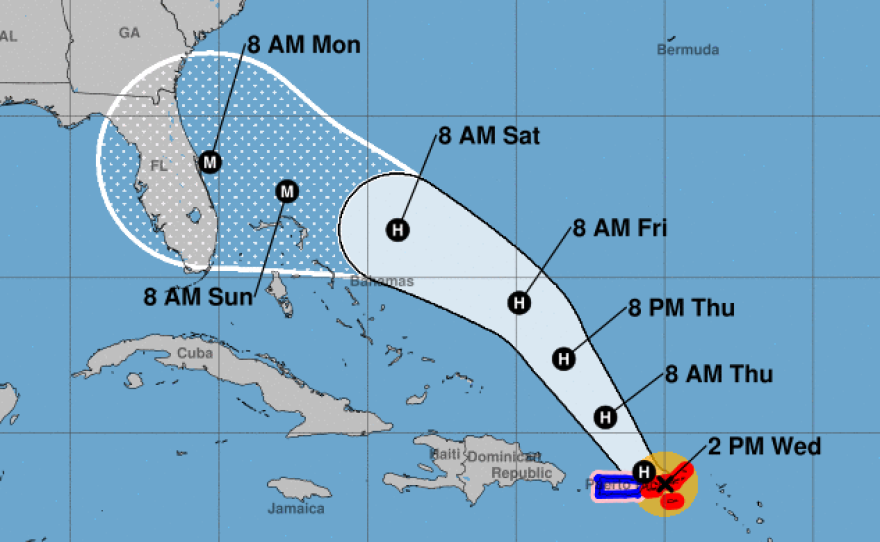Updated at 2:35 p.m. ET
Tropical Storm Dorian officially became Hurricane Dorian on Wednesday, its sustained winds topping 75 mph as it bore down on Puerto Rico and St. Thomas in the Virgin Islands. Forecasters are now warning the storm will strengthen into a dangerous Category 3 hurricane as it nears the U.S. mainland.
Puerto Rico, Vieques and the Virgin Islands are under alert, with hurricane conditions expected as the storm passes through that area. Dorian is currently crossing over St. Thomas, the National Hurricane Center says in its 2 p.m. ET update. The storm is moving toward the northwest at around 13 mph.
"An elevated weather station on Buck Island just south of St. Thomas reported a sustained wind of 82 mph ... and a gust of 111 mph," the hurricane center says.
While Dorian could lose some intensity by passing over the land mass, the storm has steadily gained power and become better organized on Wednesday. Within four days, its winds could top 115 mph, the National Hurricane Center says.
"All indications are that by this Labor Day weekend, a powerful hurricane will be near the Florida or southeastern coast of the United States," the National Hurricane Center says.
Dorian is expected to become a major hurricane (Category 3 and above) as it moves north of the Bahamas. The NHC's current predictions show Dorian's center hitting Florida's coast early Monday. But the Florida coast could see tropical-storm-force winds arrive as early as Saturday night.
The center currently predicts the storm will make landfall near an area that's roughly level with Orlando. But that potential location is subject to change drastically as the storm develops.
While the NHC initially predicted the storm would weaken somewhat into a Category 2 — with winds of 100 mph — as it drew close to Florida's coast, it quickly issued a correction to its 11 a.m. update, clarifying that the storm will likely arrive as a major hurricane.
As meteorologist Philip Klotzbach notes, "The average date for the 1st Atlantic major hurricane is September 3."
Forecasters warn of the potential for life-threatening flash floods in the storm's path. Southern and eastern portions of Puerto Rico and the Virgin Islands could see 4-6 inches of rainfall, with 10 inches possible in isolated areas. When the storm reaches Florida, it's expected to drop 4-8 inches of rain, with 10 inches in some spots.
Virgin Islands Gov. Albert Bryan Jr announced Wednesday that all schools and government offices would be closed throughout the territory due to the storm. This morning, the government also spent several hours distributing sandbags to residents. And as Dorian loomed, Bryan also instituted a public curfew from 12 noon to 6 a.m. Thursday.
As Puerto Rico prepared for the storm, Gov. Wanda Vázquez Garced ordered a freeze on prices to prevent gouging; as the storm neared, she also signed a 24-hour la Ley Seca or "dry law," prohibiting alcohol sales. Saying the island had learned lessons from Hurricane Maria's devastating arrival in September of 2017, Vázquez Garced said government agencies are better prepared to cope with an emergency.
Puerto Rico's public security agency says there are currently 56 shelters that are open to people who need help.
Noting the potential Florida landfall estimate of 8 a.m. ET Monday, NHC Director Ken Graham cautioned, "the impacts could come a lot earlier than that," saying intense rain, tropical-storm winds and a storm surge could begin to affect the coast far from the storm's center.
Acknowledging that considerable uncertainty remains over the path Dorian will take as it nears the southeastern U.S., Graham also said anyone on the coast from Florida up through Georgia and South Carolina should watch for potential hazards.
Citing data collected from Air Force Hurricane Hunters and other sources, the NHC says, "Dorian remains a compact and asymmetric tropical storm." But that could change; the center says some projection models show Dorian "increasing in size by the time it nears the southeast U.S."
While Dorian's wind speeds and size remained fairly stable earlier this week, it's now projecting tropical storm-force winds outward up to 80 miles from the center — up from 45 miles on Monday and Tuesday. Its hurricane-force winds extend up to 20 miles from the center.
As it announced an increased threat of hurricane conditions on Florida's east coast, the hurricane center noted early Wednesday that its forecasts are "on the lower end of the guidance envelope" — meaning it could raise more dire warnings as the storm continues to develop.
By 9:30 a.m. ET, Dorian's outer bands were beginning to move over eastern Puerto Rico, according to the National Weather Service office in San Juan.
To prepare for rough conditions at sea, the Coast Guard captain in San Juan set "Port Condition ZULU" Wednesday for all ports in the U.S. Virgin Islands and Puerto Rico, shutting down all commercial traffic until the storm has passed and the facilities have been assessed.
Late Tuesday, President Trump declared an emergency in the commonwealth of Puerto Rico, ordering the Federal Emergency Management Agency to provide "equipment and resources necessary to alleviate the impacts of the emergency."
Vázquez Garced thanked Trump for approving the declaration, saying it would "allow federal aid to arrive more quickly" after the storm passes.
In a statement about its preparations, FEMA said that its "stock on the island compared to 2017 levels includes three times as many generators, nine times as many meals, five times as many liters of water and 16 times as many blue tarps."
The fifth named storm of the 2019 Atlantic season formed late Tuesday, as Tropical Storm Erin's winds reached 40 mph. The storm is out in the Atlantic, several hundred miles southeast of Cape Hatteras, N.C. The storm was downgraded to a tropical depression on Wednesday. Erin is expected to remain on a north-northeastern track, likely arriving at Canada's coast late this week.
NPR's Windsor Johnston contributed to this report.
Copyright 2019 NPR. To see more, visit https://www.npr.org.






